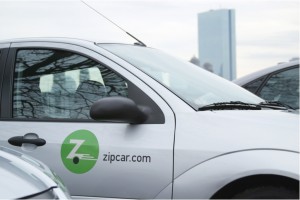
In 1999, Antje Danielson was telling her friend Robin Chase about her experience with car sharing on a trip to Berlin. Right there, in Cambridge, Mass., Danielson and Chase realized the potential of car sharing in America and Zipcar was born. Yesterday, the European influence on Zipcar seemed almost ironic– Zipcar acquired the U.K.’s fastest growing car sharing company, Streetcar for a reported $50M.
Zipcar is undeniably the leading car sharing company in the world.
Europeans. Car sharing. Zipcars—what are we talking about?
Zipcar’s car sharing works in four steps: 1) Become a Zipcar member by paying a yearly fee of $50. 2) Reserve a Zipcar (online, via iPhone app, or by phone call). 3) Unlock your Zipcar by tapping your member card on the windshield. 4) Drive and then return the car where you picked it up.
Zipcar is not a car rental– members normally pay by the hour. Props to Europe for coming up with the car sharing concept, but Zipcar, please don’t ever leave your Cambridge home base.
How did Zipcar do it? How did they surpass veteran car share companies, like Switzerland’s Mobility CarSharing or Norway’s Bilkollektivet?
1) They expanded—fast. After launching Zipcar in Boston in June 2000, they expanded into Washington D.C. in September 2001, and then in New York City in 2002. Zipcar is now in 70 cities in the United States, as well as Toronto, Vancouver, and London. In 2007 Zipcar merged with American competitor, Flexcar, which was headquarted in Seattle Wash. Zipcar also grabbed a stake in Spanish car share company, Avancar in 2009. With the purchase of Streetcar Zipcar will add 1,100 locations in 8 cities across the United Kingdom.
2) Zipcar made their iphone app memorable. 25% of Zipsters (Zipcar users) are iPhone users, but Zipcar didn’t make a basic car-reservation app. Zipcar’s app uses geo-location technology to find the closest available Zipcar, and users can make a reservation through it as well. Best part of all, you can unlock your Zipcar from the iPhone application. Other car companies had iPhone apps, but could their app unlock the car? Didn’t think so.
3) They tapped college campuses. Most student’s’budgets don’t allow them to keep a car on campus. Considering college campus’ are like mini-cities, Zipcar set up shop in over 100 campuses across the United States. Students pay $35 per year, plus a rental fee and can use a Zipcar whenever they need. Unlike other car rental companies, Zipcar allows 18-year-olds drive university Zipcars. Entering the college campuses keeps Zipcar young, and provides them a seriously loyal user base.
While Zipcar has made the right moves to position itself as leading car share company worldwide, they had a rocky start. Founder Robin Chase was forced out as CEO in February 2003 after an investor who pledged $5M backed out. Zipcar’s inability to get market traction and VC funding caused the board to replace Chase with current CEO, Scott Griffith. Griffith took Zipcar where it is today– re-branding it as a hip way to drive for city dwellers rather than keeping Zipcar’s main focus on its ec0-friendliness. Griffith and Zipcar brought $130M in revenue last year.
Zipcar beat the Europeans in their own car sharing game; Zipcar was more organized, efficient, and innovative than their European competitors. Could you accuse Chase and Danielson of stealing the Europeans car sharing idea? Perhaps, but they executed a car sharing program better, and as we like to say at BostInnovation, execution is what counts.
Zipcar will continue to take their iconic cars to global markets. As a Zipcar member you’ll be able to drive all over the world, or at least in Europe and North America. We’rem considering getting Zipcar even though we don’t need it; BostInno’s team just wants to be able to unlock cars from our iPhones.
